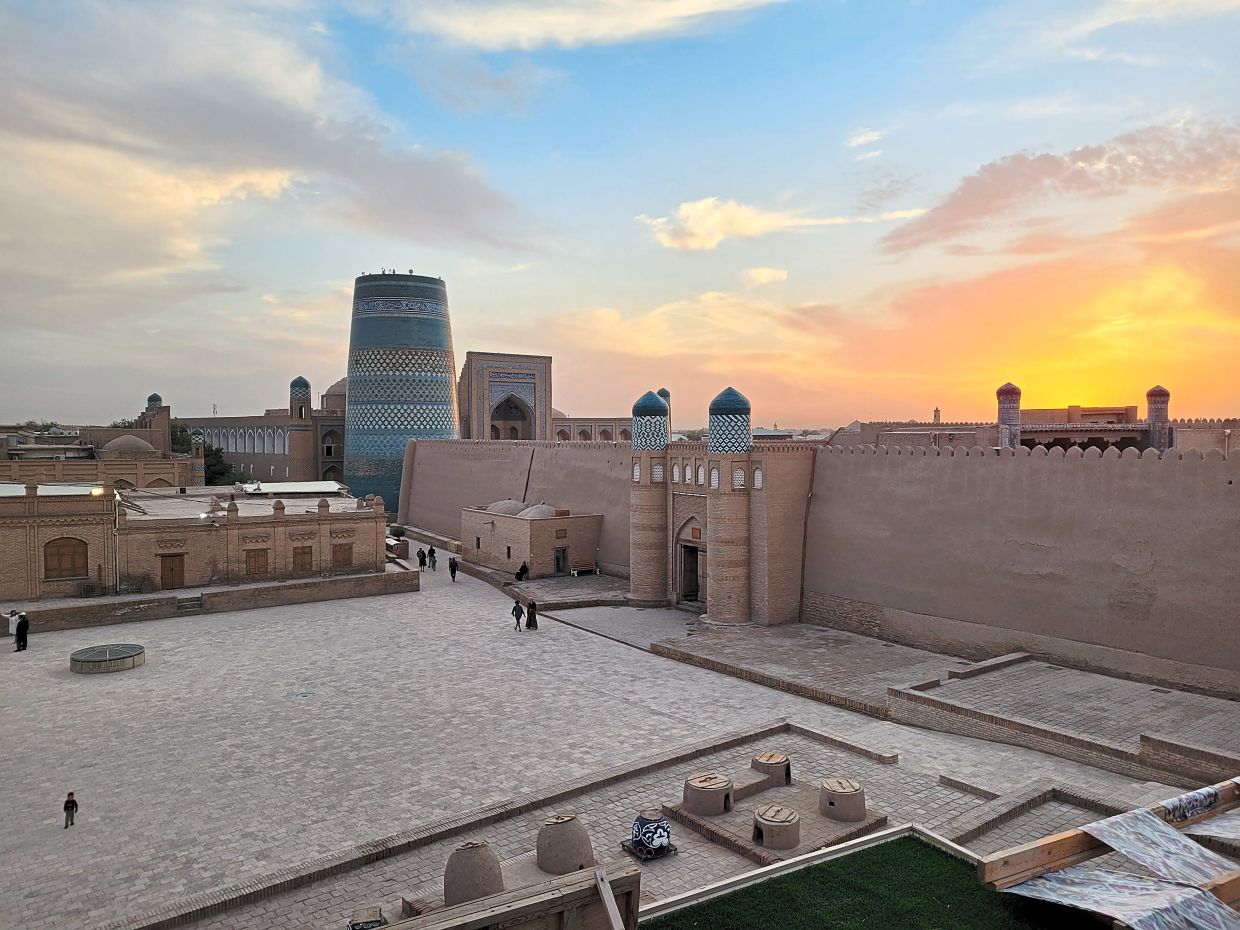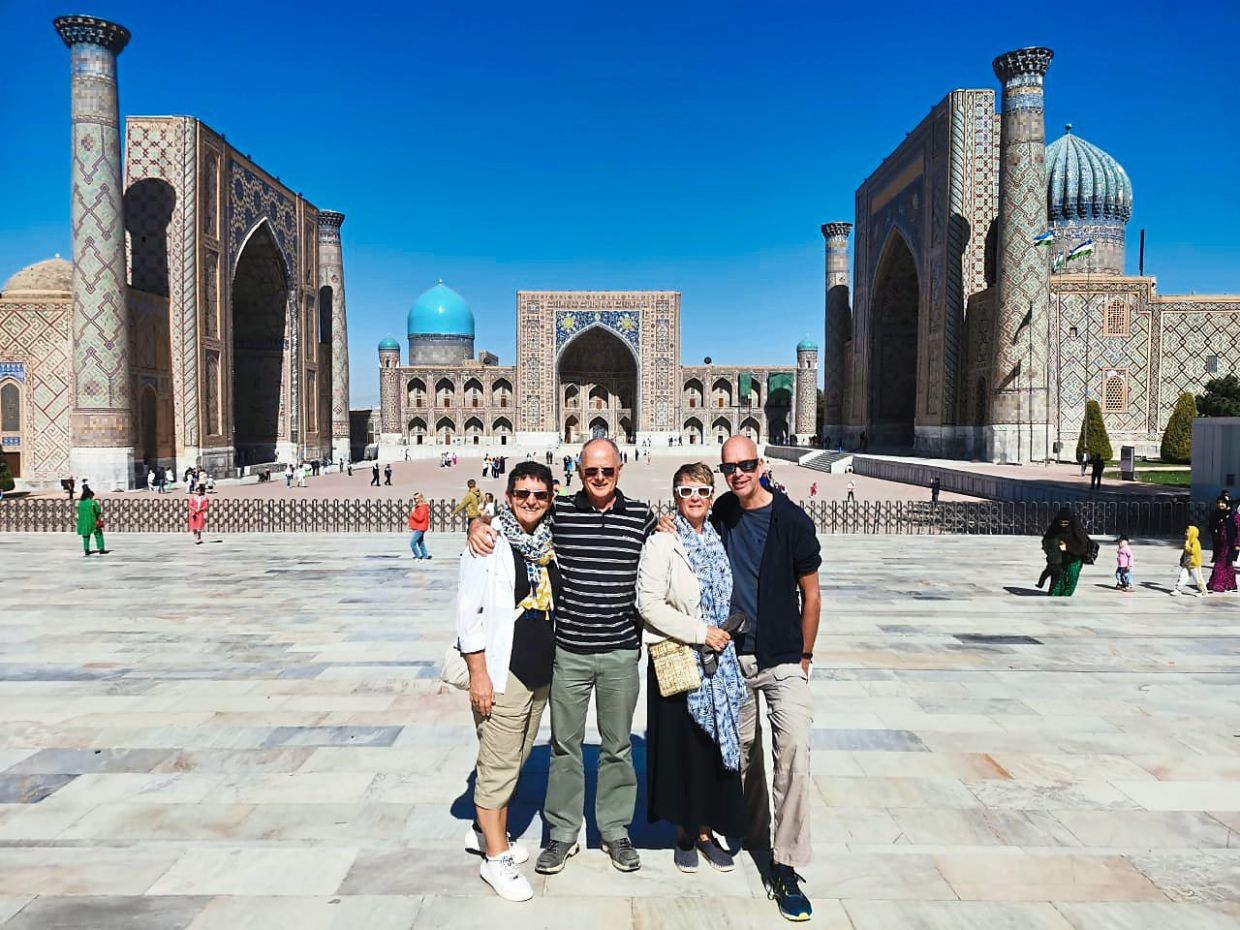The ancient city walls of Khiva. — Photos: FRANK LUCAS
We recently visited a handful of cities in Uzbekistan, namely Khiva, Bukhara and Samarkand, as well as the Aral Sea, which are part of the historical Silk Road route. The trip took more than two weeks and over 3,300km to complete, via plane, car and train.
Our journey began in the capital city of Tashkent, where we flew to Nukus and then hired a private vehicle to get to the Aral Sea. The drive was not smooth as the roads were in bad condition. But still, we managed to get to Moynaq, which is an abandoned harbour near the Aral Sea.
Here, we checked out a ship graveyard, where rusty hulks now lie stranded in the sand. There were names carved on the bows.
The Aral Sea used to be the fourth biggest lake in the world. But in the last 50 years this lake is shrinking, because all the inflowing water was diverted to irrigate the arid plains to grow cotton.
We then went to a yurt camping ground where I caught a glimpse of the sea in the horizon. This endorheic lake is salty, contaminated with pesticides and other toxic chemicals left from the Soviet Union era (they used to produce biochemical weapons here during the Cold War).
Since our trip was in autumn, the average temperature at night was 6°C. We slept comfortably in our yurts, keeping warm with thick blankets.
We went to Khiva the next day, crossing another 300km of desert. We passed by a 13th century graveyard of nomadic tribes, a deep canyon and the 12th century ruins of a caravansary (an inn with a central courtyard).
After driving for three hours, we stopped at an abandoned airstrip. The place was full of Soviet-style buildings, most of which were in disrepair. There was even a school that kind of looked like it was haunted as the windows were broken and the paint was peeling.
Boys played football on an impoverished pitch nearby, while on the horizon, we saw the flares of a gas compressor station. We passed more than 25 derricks and saw markers of underground pipelines crossing these vast plains.
This is the autonomous region of Karakalpakstan, home to an ethnic group. On their land, natural gas is explored, but a big chunk of the revenue goes to the capital, Tashkent, which is dominated by the Uzbeks. Our driver told us that the local Karakalpak people were not happy with this arrangement.
Meanwhile, the city of Khiva dates back to the 8th century, when it was an important commercial, cultural and intellectual centre on the Silk Road. It was here that Al’Khwarizmi invented important Maths equations like algorithm and algebra.
we entered the city centre, Ichan Kala, where ancient structures like blue domes and slender minarets decorated with mint-green tiles, as well as the mud city walls dominated the skyline. The extreme dry desert climate helps to preserve these old structures.
We sat inside the 1,000-year-old Juma mosque and saw that most of the 218 intricately carved wooden pillars were the original ones.
At the crack of dawn, I jogged around the city walls. I was impressed by its size. The mud walls are 2km long and 12m high, with semi rounded towers and four gates. I crossed a square which, until 1917, was the biggest slave market in Central Asia.
From Khiva we went to Bukhara, passing by windswept plains. I saw Chinese flags in front of a greenhouse complex and Chinese contractors making cement for a new highway – they seem to be rebuilding the Silk Road.
Old ways
In Bukhara, we experienced what life was like back in the day, when people lived in mud brick houses. We sat near a pond fed by irrigation canals that were used for ablution. There was also one caravansary for the Dervish folk.
I could smell the aroma of spices, incense and even cheeses. “The sound of this ghijak (lute) resembles that of a violin,” said a shop owner, whose family has been making the traditional music instrument for many generations. Ancient craft like this, together with carpet-making, gold embroidery and woodcarving are still being practised here today. Strolling through the narrow alleys of Bukhara, I could really feel the history of the place.
Later, in Samarkand, we visited the Regisan square. What an experience it was. Regisan is the iconic 9th-century building that many associate Uzbekistan with. The square is surrounded by three madrassa with blue and turquoise domes and rectangular entrance portals with lancet arches. Four ceramic mosaics cover minarets towered as huge sentries. I stood in the middle of the square taking it all in.
Our guide was named Victoria, and she talked fast. Without guides like her we would never have found the places we visited. She showed us the Ulug Bek observatory, a half underground quadrant built in 15th century for astronomic sciences. Back then, Samarkand was the most advanced astronomical centre in the world.
We concluded our visit to Samarkand at Necropolis, a must-visit place where the cousin of Prophet Mohammed is buried in a mausoleum. His tomb is a simple white block.
It was interesting looking at all the local people in the places we visited. Most men wore traditional skullcaps called the tubeteikas, while elderly women wore traditional gowns and headscarves. There were also a few women dressed in more Western attire. The people did not smile much and seemed to be abrupt. But we did encounter a few groups that were very friendly.
We also witnessed a number of weddings at many of the towns we visited, where brides and grooms were paraded in the streets with their family and friends.
One evening, we had dinner in a local restaurant in Samarkand. People ate a lot of meat and “non”, a traditional Uzbek flatbread. There was a wedding party in the restaurant that night, too, and we were invited to join in the celebrations. This was quite a nice experience for us.
Uzbekistan is a multi-cultural country with different ethnic groups who speak in Tajik, Uzbek, Russian and Karakalpak. The country is blessed with stunning historic sites and natural resources. However, its landlocked isolation in Central Asia makes it an off-the-beaten-track destination for travellers.
The views expressed are entirely the reader’s own.
Write to us
We can finally travel again! We would love to hear about your travels and adventures. If you don’t feel like travelling yet, that’s OK, as you can always tell us about your past holidays instead. Your story – experiences, tips, advice – should be 700 to 800 words long in Word or Text format. Please attach some photos (1MB, captioned) in a separate email. There is no payment for submissions, and we reserve the right to edit all submissions. Email star2travel@thestar.com.my with the subject “Readers Share”.








